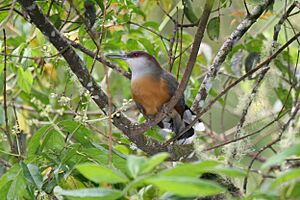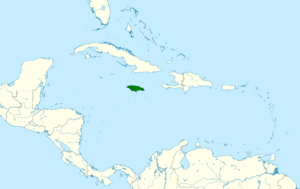Jamaican lizard cuckoo facts for kids
Quick facts for kids Jamaican lizard cuckoo |
|
|---|---|
 |
|
| Conservation status | |
| Scientific classification | |
| Genus: |
Coccyzus
|
| Species: |
vetula
|
 |
|
| Synonyms | |
|
|
The Jamaican lizard cuckoo (Coccyzus vetula) is a special type of bird. It belongs to the cuckoo family, Cuculidae. This bird lives only on the island of Jamaica. It is found nowhere else in the world!
Contents
About the Jamaican Lizard Cuckoo
How Scientists Classify This Bird
Scientists group living things to understand them better. The Jamaican lizard cuckoo was once thought to be the same as three other types of lizard cuckoos. They were also placed in a different group called Saurothera. Now, all these birds are part of the Coccyzus group. The Jamaican lizard cuckoo is a unique species within this group.
What Does It Look Like?
The Jamaican lizard cuckoo is about 38 to 40 centimeters (15 to 16 inches) long. That's about the length of your forearm! Half of its length is its long tail. It weighs between 86 and 105 grams (3 to 3.7 ounces). This is about the weight of a small apple.
This bird has a long, straight beak. The top part of its beak is black, and the bottom part is lighter. Both male and female birds look the same. They have a brown head and neck. Their upper body is grayish, with reddish-brown flight feathers. Their throat is whitish, and their belly is a reddish-brown color. The feathers under their tail are lighter.
Their tail feathers are gray with wide white tips. The two middle tail feathers have a black band above the white tip. A cool feature is the bare red skin around their eyes. Young birds have narrower tail feathers and yellowish tips on some of their wing feathers.
Where Does It Live?
The Jamaican lizard cuckoo lives all over the island of Jamaica. You can find it from the coast all the way up to 1,200 meters (about 3,900 feet) high in the mountains. It mostly lives in thick, green tropical forests. You might also spot it in more open woodlands or areas with scattered trees and shrubs.
Behavior and Life Cycle
How It Moves Around
This cuckoo is not a migratory bird. This means it stays in Jamaica all year long. It does not fly to other places for different seasons.
What It Eats
The Jamaican lizard cuckoo usually looks for food in the middle and top parts of the forest trees. It runs along branches and glides from one tree to another. It eats many different things. Its diet includes Anolis lizards, which are small reptiles. It also eats adult insects and their larvae (young forms). Sometimes, it will eat mice, baby birds, and even tree frogs. Young cuckoos are mostly fed lizards by their parents.
Reproduction
The breeding season for the Jamaican lizard cuckoo is usually from March to August. However, they have been seen courting in October too. They build a flat nest using twigs and line it with leaves. They hide their nest well, often in a tangled group of branches or inside bromeliad plants. Both the male and female birds take turns sitting on the eggs to keep them warm. They also both help to feed and care for the baby birds.
What Does It Sound Like?
The main sound the Jamaican lizard cuckoo makes is a fast, low "cak-cak-cak-ka-ka-ka-k-k."
Conservation Status
The IUCN (International Union for Conservation of Nature) has listed the Jamaican lizard cuckoo as a species of "Least Concern." This means it is not currently in danger of disappearing. However, it lives in a rather small area, and we don't know exactly how many of these birds there are. Scientists believe their numbers might be slowly going down. No immediate big threats have been found. Even though it's found across Jamaica, it's not a very common bird to see. More research is needed to learn about its breeding habits and other parts of its life.


